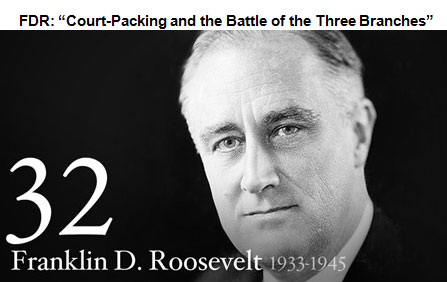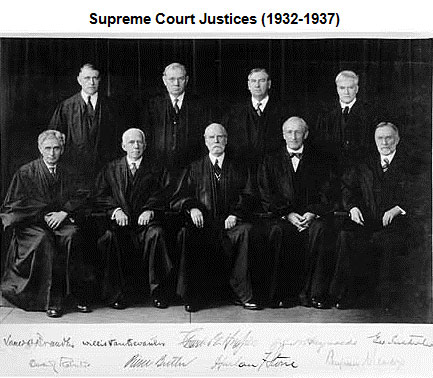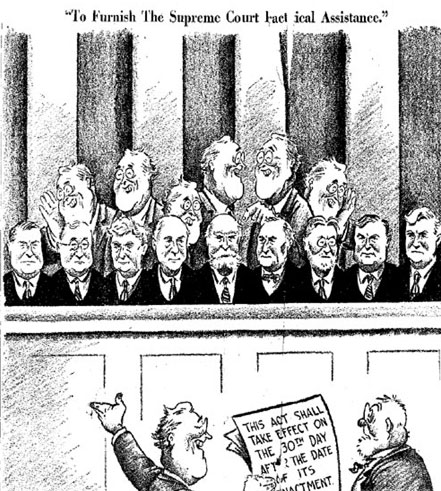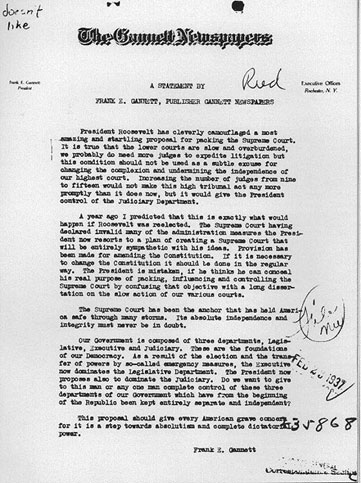
Source: 32fr header sm, The White House

Source: 32fr header sm, The White House
President Franklin D. Roosevelt was elected the 32nd President of the United States. Roosevelt was elected during one of the United States’ most devastating economic declines in history. The nation had experienced the crash of the stock market, the failures of its banking system, and high unemployment rates. Most Americans had experienced loss in ways that no American had experienced before.
Roosevelt was charged with repairing the economy and putting Americans back to work. His plan, the New Deal, was aimed at ending the economic crisis. With his executive power and the help of the legislative branch, Roosevelt developed a multitude of reform programs. Congress supported Roosevelt by approving most of the programs without great resistance. The New Deal programs were implemented quickly so that American citizens could benefit from them. Within the first 100 days of his presidency, many of the New Deal programs were underway.

Source: Crane operator at TVA's Douglas Dam, Tennessee, Alfred Palmer, Library of Congress
The New Deal programs were large in number. Known as the alphabet agencies, the programs focused on work relief, labor and banking reform. There were programs that supported farmers and those who lived in rural areas; other programs serviced business owners to help regulate businesses.

Source: Supreme Court 1932, Mhym, Wikimedia
The New Deal programs required the federal government to support the people of the United States. However, not everyone was pleased with the New Deal. There were several lawsuits brought before the Supreme Court. Initially, the Supreme Court supported the New Deal in cases that were brought before them, but by 1935, the majority of the justices, pictured above, began to change views on government involvement in the private affairs of the people.
In 1935, the Supreme Court declared two major programs unconstitutional, halting the progress of the New Deal.
Something to think about: Do you agree with the Supreme Court that these acts were unconstitutional?
By 1936, Roosevelt was reelected and proposed a new plan. His new plan called for changes within the Supreme Court. The “Court-Packing Plan,” as Roosevelt’s proposal was called, involved adding a new justice to the Supreme Court each time a sitting justice turned 70 years old without retiring. Additionally, he proposed a lucrative pension program for federal judges who retired. The plan did not work; in fact, it caused many people to think that the executive branch was interfering with the power of the other two branches. Some feared that the president was ignoring the separation of powers that the constitution provided.
Why do you think Roosevelt proposed to replace justices who were 70 years old? How would this proposal help Roosevelt‘s agenda?


Source: To Furnish the Supreme Court Practical Assistance, The University of Virginia
Analyze the cartoon: Do you think the cartoon shown above supports or does not support the way most Americans felt about Roosevelt’s proposal? Whom is the cartoonist portraying in the first row (seated)? What is the significance of the multiple FDRs in the background? What act is referred to on the document that FDR holds at the bottom of the cartoon?


Source: Gannett- Letter, Frank E. Gannett, National Archives
Many people in the United States opposed Roosevelt’s proposed solution. The press played a role in the public perception of the president and the Supreme Court. One member of the press, newspaper publisher Frank E. Gannett, published his opinion of the situation. Read an excerpt from his statement below.
“Our Government is composed of three departments, Legislative, Executive and Judiciary. These are the foundations of our Democracy. As a result of the election and the transfer of powers by so-called emergency measures, the Executive now dominates the Legislative Department. The President now proposes also to dominate the Judiciary. Do we want to give to this man or any one man complete control of these three departments of our Government which have from the beginning of the Republic been kept entirely separate and independent?
This proposal should give every American grave concern for it is a step towards absolutism and complete dictatorial power.”
-Excerpt from Frank E. Gannett, publisher The Gannett Newspapers
Answer the following questions about Gannett’s letter in your notes.
Interactive popup. Assistance may be required.
In his letter, Gannett references the separation of powers in his statement, “Our Government is composed of three departments, Legislative, Executive and Judiciary. These are the foundations of our Democracy.”
Interactive popup. Assistance may be required.
Gannett accused Roosevelt of taking over the legislative branch. His letter states, " . . . the Executive now dominates the Legislative Department." He is referring to Roosevelt being able to make the New Deal laws and programs without interference from Congress. Making laws is one of the powers of Congress.
Soon after Roosevelt was reelected, and he announced his proposal, the Supreme Court began to change its tone and started to uphold New Deal programs. The “Court-Packing Plan” was never implemented, but it did illustrate the issues between the three branches during this period. The judicial branch checked the legislative and executive branches.
Let’s reflect: How did the relationship between the executive and legislative branches impact the New Deal? How did the relationship between the executive and judicial branch change as a result of Roosevelt’s “Court-Packing” proposal?
